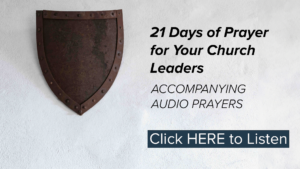Being Thankful For God’s Small Wonders
As a pastor to pastors, I see a lot of pain and discouragement. One pastor said to me a while back, “If it were just a jungle out there, I could handle that, but it’s worse than a jungle!” He was probably having a pretty rough day, but the truth is there are many things in the ministry that take a toll on us — so much so that, if we are not careful, we can miss the blessings and overlook the joy.
Henri Nouwen writes in his book The Return of the Prodigal Son, “I am not accustomed to rejoicing in things that are small, hidden, and scarcely noticed by the people around me. … I have become accustomed to living with sadness and so have lost the eyes to see the joy.”
Life will do that to us if we are not careful and, when it does, we will become calloused and cynical. If that ever happens, we need to step back, take a look at our motivation, and ask God to forgive us.
Have you taken a close look recently at what the early English colonists experienced before they famously sat down for that first Thanksgiving meal? Here’s a seasonally relevant refresher course, taken and edited from thehistory.com Web site:

The Pilgrims Before the Mayflower
In 1608, a small congregation of disgruntled English Protestants from the village of Scrooby, Nottinghamshire, left England and moved to Leyden, a town in Holland. These “Separatists” did not want to pledge allegiance to the Church of England — which they believed was nearly as corrupt and idolatrous as the Catholic Church it had replaced — any longer. (They were not the same as the Puritans, who had many of the same objections to the English church, but wanted to reform it from within.) The Separatists hoped that, in Holland, they would be free to worship as they liked
In fact, the Separatists (they called themselves “Saints”) did find religious freedom in Holland, but they also found a secular life that was more difficult to navigate than they’d anticipated. For one thing, Dutch craft guilds excluded the migrants, so they were relegated to menial, low-paying jobs. Even worse was Holland’s easygoing, cosmopolitan atmosphere, which proved alarmingly seductive to some of the Saints’ children. (These young people were “drawn away,” Separatist leader William Bradford wrote, “by evill [sic] example into extravagance and dangerous courses.”) For the strict, devout Separatists, this was the last straw. They decided to move again, this time to a place without government interference or worldly distraction: the “New World” across the Atlantic Ocean.
The Mayflower
First, the Separatists returned to London to get organized. A prominent merchant agreed to advance the money for their journey. The Virginia Company gave them permission to establish a settlement, or “plantation,” on the East Coast between 38 and 41 degrees north latitude (roughly between the Chesapeake Bay and the mouth of the Hudson River). And the King of England gave them permission to leave the Church of England, “provided they carried themselves peaceably.”
In August 1620, a group of about 40 Saints joined a much larger group of (comparatively) secular colonists — “Strangers” to the Saints — and set sail from England on two merchant ships: the three-masted Mayflower and the Speedwell. The smaller Speedwell began to leak almost immediately, however, and the ships headed back to port. The travelers squeezed themselves and their belongings onto the Mayflower and set sail once again. Typically, the Mayflower’s cargo was wine and dry goods, but on this trip, the ship carried passengers: 102 of them, all hoping to start a new life on the other side of the Atlantic.
Because of the delay caused by the leaky Speedwell, the Mayflower had to cross the Atlantic at the height of storm season. As a result, the journey was horribly unpleasant. Many of the passengers were so seasick they could scarcely get up, and the waves were so rough that one “Stranger” was swept overboard and drowned. (It was “the just hand of God upon him,” Bradford wrote later, for the young sailor had been “a proud and very profane yonge man.”)

The Mayflower Compact
After two miserable months at sea, the ship finally reached the New World. After sending an exploring party ashore, the Mayflower landed in mid-December at what they would call Plymouth Harbor, on the western side of Cape Cod Bay. There, the Mayflower’s passengers found an abandoned Indian village and not much else. They also found that they were in the wrong place: Cape Cod was located at 42 degrees north latitude, well north of the Virginia Company’s territory. Technically, the Mayflower colonists had no right to be there at all. In order to establish themselves as a legitimate colony (“Plymouth,” named after the English port from which they had departed) under these dubious circumstances, 41 of the Saints and Strangers drafted and signed a document they called the Mayflower Compact. This Compact promised to create a “civil Body Politick” governed by elected officials and “just and equal laws.” It also swore allegiance to the English king.
Plymouth Colony
The colonists spent the first winter, which only 53 passengers and half the crew survived, living onboard the Mayflower. During those next several months, the settlers ferried back and forth from shore to build their new storage and living quarters. The settlement’s first fort and watchtower was built on what is now known as Burial Hill. Once they moved ashore in March 1621, the colonists faced even more challenges. (The Mayflower sailed back to England in April.) As noted, during their first winter in America, more than half of the remaining Plymouth colonists died from malnutrition, disease, and exposure to the harsh New England weather. In fact, without the help of the area’s native people, it is likely that none of the colonists would have survived.
The native inhabitants of the region around Plymouth Colony were the various tribes of the Wampanoag people, who had lived there for some 10,000 years before the Europeans arrived. Soon after the Pilgrims built their settlement, they received an astonishing visit from an Abenaki Indian who greeted them in English. Several days later, he returned with another English-speaking Native American, Tisquantum, or Squanto. Squanto was a member of the Pawtuxet tribe (from present-day Massachusetts and Rhode Island) who had been seized by the explorer John Smith’s men in 1614-15. Meant for slavery, he somehow managed to escape to England, then returned to his native land to find most of his tribe had died of plague. In addition to interpreting and mediating between the colonial leaders and Native American chiefs (including Massasoit, chief of the Pokanoket), Squanto taught the Pilgrims how to plant corn, which became an important crop, as well as where to hunt beaver, extract sap from maple trees, catch fish in the rivers, and avoid poisonous plants.

The First Thanksgiving
In November 1621, after the Pilgrims’ first corn harvest proved successful, Governor William Bradford organized a celebratory feast and invited a group of the fledgling colony’s Native American allies, including the Wampanoag chief Massasoit. Now remembered as American’s “first Thanksgiving” — although the Pilgrims themselves may not have used the term at the time — the festival lasted for three days. While no record exists of the historic banquet’s exact menu, the Pilgrim chronicler Edward Winslow wrote in his journal that Governor Bradford sent four men on a “fowling” mission in preparation for the event, and that the Wampanoag guests arrived bearing five deer. Historians have suggested that many of the dishes were likely prepared using traditional Native American spices and cooking methods. Because the Pilgrims had no oven and the Mayflower’s sugar supply had dwindled by the fall of 1621, the meal did not feature pies, cakes, or other desserts, which have become a hallmark of contemporary celebrations, but rather included lobster, seal, and swans.
Eventually, the Plymouth colonists were absorbed into the Puritan Massachusetts Bay Colony. Still, the Mayflower Saints and their descendants remained convinced that they alone had been specially chosen by God to act as a beacon for Christians around the world. “As one small candle may light a thousand,” Bradford wrote, “so the light here kindled hath shone to many, yea in some sort to our whole nation.”
Bradford and the other Plymouth settlers were not originally known as Pilgrims, but as “Old Comers.” This changed after the discovery of a manuscript by Bradford in which he called the settlers who left Holland “saints” and “pilgrimes.” In 1820, at a bicentennial celebration of the colony’s founding, the orator Daniel Webster referred to “Pilgrim Fathers,” and the term stuck.
For more than two centuries, days of thanksgiving were celebrated by individual colonies and states. It wasn’t until 1863, in the midst of the Civil War, that President Abraham Lincoln proclaimed a national Thanksgiving Day to be held each November.

The life of the pilgrims was not easy, but I think their faith in God allowed them to see the small blessings around them during those hard times. They knew how to be thankful for the small wonders that surround anyone who follows Christ.
The roads I travel take me to places where my brothers are struggling with the “what ifs” more than the “why nots.” They have permitted the naysayers and the joy suckers to influence their emotions and responses. They have overlooked their blessings.
My colleague, please be aware of God’s small wonders. Look around you with eyes open and heart ready to receive even the simplest pleasures. When you do, you will be a vessel of happiness to those you encounter.
“Rejoice in the Lord always. I will say it again: Rejoice!” (Philippians 4:4).
©2013 HB London. Originally posted on HB London’s, The Heart of A Pastor Blog.


